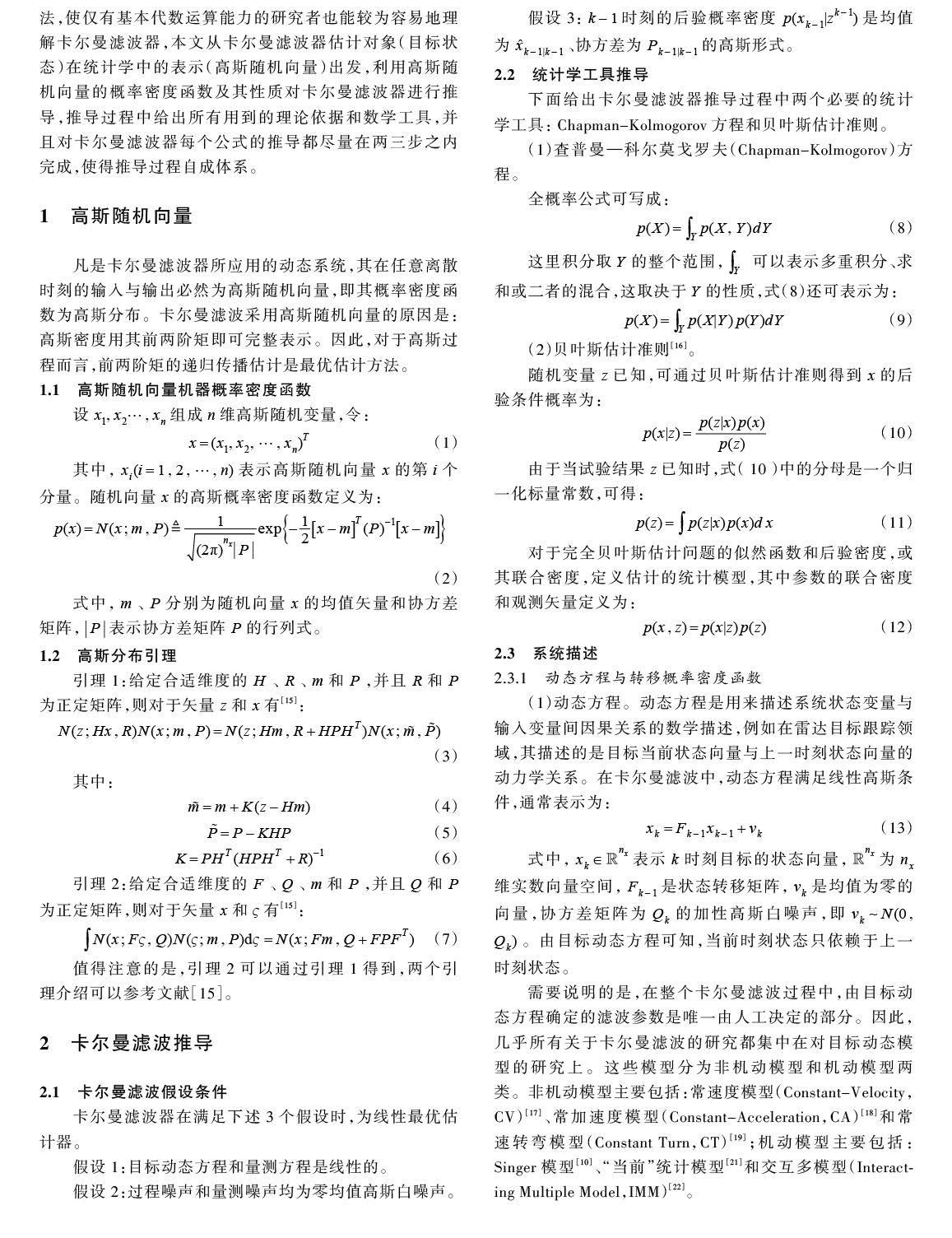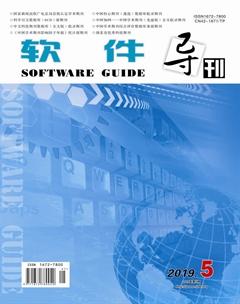基于高斯随机向量统计特性的卡尔曼滤波器推导方法
唐子奇 谢岚 张玉萍



摘 要:为帮助需要深入了解卡尔曼滤波器的研究人员或使用卡尔曼滤波器的工程人员深入学习这一非常有用的工具,利用高斯随机向量及其统计学特性,尤其是概率密度函数对卡尔曼滤波递归方程进行推导。在推导过程中,给出了卡尔曼滤波器推导所需的相关理论依据及数学工具。该推导方法简单、直观,更便于人们理解卡尔曼滤波器工作机理,并根据实际应用过程进一步開展更深层次的研究。
关键词:高斯随机向量;概率密度函数;卡尔曼滤波器
DOI:10. 11907/rjdk. 191361
中图分类号:TP3-0 文献标识码:A 文章编号:1672-7800(2019)005-0058-04
Abstract:To help researchers to have in-depth study of Kalman filter or engineers using Kalman filters to learn this very useful tool, the Gaussian random vector and its statistical properties, especially the probability density function, the recursive equation of Kalman filter was derived. In the process of derivation, all the mathematical tools needed for the Kalman filter derivation and the corresponding literature are given. The working mechanism of the Kalman filter can be understood without additional query of other data. In addition, specific references are given for the extension part of the Kalman filter for researchers to conduct further research.
Key Words: Gaussian random vector; probability density function; Kalman filter
0 引言
为了克服维纳滤波器工程实现较为困难的缺点,1960年匈牙利数学家Rudolf Emil Kalman提出了卡尔曼滤波器[1-2]。卡尔曼滤波器提出至今已将近60年,并被广泛应用于各个领域[3-9],但其依然是目标跟踪与数据融合等领域最有效且常用的工具之一。因此,有必要对其递推方程进行推导,从基本数学公式深入理解卡尔曼滤波器的每条方程,以便能更加灵活地加以应用,或根据具体应用情况对其性能进行改进完善。
卡尔曼滤波是离散时间状态空间线性模型下的最小均方误差估计[10-11],而在卡尔曼滤波递归过程中传递的是目标状态估计均值与误差协方差矩阵。因此,典型的卡尔曼滤波器推导方法是利用线性最小均方误差估计准则寻找使误差最小的目标状态估计[12-13]。该方法中涉及许多向量与矩阵的数学计算,计算过程较为复杂。因此,该推导方式适合数学功底(特别是随机过程相关知识)比较深厚的研究人员。文献[14]从一列火车沿铁路运动这一简单跟踪问题出发,利用两个高斯概率密度函数乘积依然服从高斯分布的性质推导了卡尔曼滤波。
为了寻求一种简单、直观且系统的卡尔曼滤波推导方法,使仅有基本代数运算能力的研究者也能较为容易地理解卡尔曼滤波器,本文从卡尔曼滤波器估计对象(目标状态)在统计学中的表示(高斯随机向量)出发,利用高斯随机向量的概率密度函数及其性质对卡尔曼滤波器进行推导,推导过程中给出所有用到的理论依据和数学工具,并且对卡尔曼滤波器每个公式的推导都尽量在两三步之内完成,使得推导过程自成体系。
1 高斯随机向量
凡是卡尔曼滤波器所应用的动态系统,其在任意离散时刻的输入与输出必然为高斯随机向量,即其概率密度函数为高斯分布。卡尔曼滤波采用高斯随机向量的原因是:高斯密度用其前两阶矩即可完整表示。因此,对于高斯过程而言,前两阶矩的递归传播估计是最优估计方法。
3 结语
为了实现一种系统且简单易懂的卡尔曼滤波器推导方法,从卡尔曼滤波器估计对象(目标状态)在统计学中的表示(高斯随机向量)出发,首先给出了高斯随机变量定义及其概率密度函数,并且给出了高斯分布引理,其中两个引理在卡尔曼滤波器推导过程中起到了关键性作用;其次,给出卡尔曼滤波器需要满足的假设条件,只有在这些条件下,卡尔曼滤波器才是最优的;接下来进一步介绍了推导过程中两个必要的统计学工具;最后对卡尔曼滤波器进行推导,推导过程中介绍了所有用到的数学工具,使整篇文章自成体系,并且对每一处关键理论都给出了参考文献,以便研究人员对卡尔曼滤波算法开展更深入的研究。
参考文献:
[1] KALMAN R E. A new approach to linear filtering and prediction problems[J]. Journal of basic Engineering,1960,82(1): 35-45.
[2] 彭丁聪. 卡尔曼滤波的基本原理及应用[J]. 软件导刊, 2009(11):32-34.
[3] 孙海波,童紫原,唐守锋,等. 基于卡尔曼滤波与粒子滤波的SLAM研究综述[J]. 软件导刊, 2018(12):1-3.
[4] 徐嵩,王剑平,侯明. 基于卡尔曼滤波算法的智能铅鱼测深系统研究[J]. 软件导刊, 2018 (5):97-101,105.
[5] 陈丹,徐健锐. 基于GRNN并融合卡尔曼滤波实现短时交通流预测[J]. 软件导刊, 2012, 11(8):23-25.
[6] 余达清. 微粒群算法在改进基于卡尔曼滤波的飞机航迹融合上的应用[J]. 软件导刊,2013,12(10):51-53.
[7] 李莉.伪线性卡尔曼滤波在目标被动跟踪中的应用[J].软件导刊,2009,8(11):30-32.
[8] CHEN Z, ZOU H, JIANG H, et al. Fusion of WiFi, smartphone sensors and landmarks using the Kalman filter for indoor localization[J]. Sensors, 2015, 15(1): 715-732.
[9] AZAM S E, CHATZI E, PAPADIMITRIOU C, et al. A dual Kalman filter approach for state estimation via output-only acceleration measurements[J]. Mechanical Systems and Signal Processing, 2015: 866-886.
[10] CHEN B, LIU X, ZHAO H, et al. Maximum correntropy Kalman filter[J]. Automatica, 2017, 76: 70-77.
[11] PAN J, YANG X, CAI H, et al. Image noise smoothing using a modified Kalman filter[J]. Neurocomputing, 2016: 1625-1629.
[12] BOARDMAN T J. Prediction and improved estimation in linear models[J]. Technometrics, 1979, 21(4): 582-582.
[13] HERNANDEZ S, TEAL P D. Multi-target tracking with poisson processes observations[C]. Pacific-rim Symposium on Image and Video Technology, 2007: 474-483.
[14] FARAGHER R. Understanding the basis of the Kalman filter via a simple and intuitive derivation[J]. IEEE Signal Processing Magazine, 2012,29(5):128-132.
[15] HO Y, LEE R C. A Bayesian approach to problems in stochastic estimation and control[J]. IEEE Transactions on Automatic Control, 1964, 9(4): 382-387.
[16] HAUG A J. Bayesian estimation and tracking: a practical guide [M]. New York:Springer, 2012: 117-118.
[17] BARSHALOM Y,LI X. Estimation and tracking: principles, techniques, and software[J]. IEEE Antennas and Propagation Magazine, 1996.
[18] BAR-SHALOM Y. Cable, tracking and data association[J]. Journal of the Acoustical Society of America, 1988,87(2): 918-919.
[19] BIERMAN G. Stochastic models, estimation, and control[J]. IEEE Transactions on Automatic Control, 1983, 28(8): 868-869.
[20] SINGER R A. Estimating optimal tracking filter performance for manned maneuvering targets [J]. IEEE Transactions on Aerospace & Electronic Systems, 1970,6(4): 473-483.
[21] KUMAR K S P,ZHOU H. A 'current' statistical model and adaptive algorithm for estimating maneuvering targets[J]. Journal of Guidance Control & Dynamics, 1984,7(5): 596-602.
[22] BLOM H A, BARSHALOM Y. The interacting multiple model algorithm for systems with Markovian switching coefficients[J]. IEEE Transactions on Automatic Control, 1988, 33(8): 780-783.
[23] GREWAL M S,ANDREWS A P. Kalman filtering: theory and practice using MATLAB[M]. New York:Wiley,2001:50-80.
(責任编辑:黄 健)

